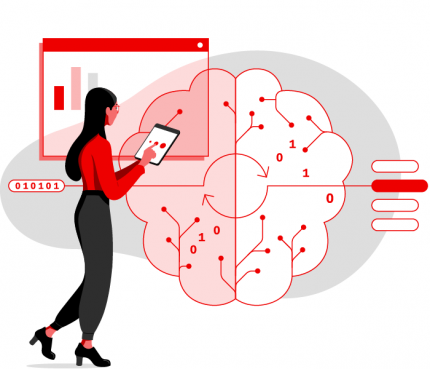Blog da Red Hat
The Red Hat Shares newsletter helps IT leaders navigate the complicated world of IT―the open source way.
FROM THE EDITOR

AI/ML: Go beyond science fiction into real-world applications
Artificial intelligence (AI) is rules-based software that performs tasks typically accomplished with human intervention. Machine learning (ML) is a subset of AI in which the AI is able to learn and develop over time. These two terms are often combined as AI/ML. AI/ML helps organizations extract insights and value from the massive amounts of data they collect.
While the term may conjure images of robots and science fiction, real-world AI/ML applications are shaping societies in numerous (and sometimes unexpected) ways. According to Grand View Research, "the global [AI] market size was valued at US$62.35 billion in 2020 and is expected to expand” to US$997.8 billion by 2028. It’s no wonder with all sorts of industries using AI/ML―including to advance breast cancer detection, help reduce road deaths, improve education, and even help people invest via “AI-powered robo-advisors.”
During the COVID-19 pandemic, AI has contributed a lot―from more accurately “measuring the temperatures of thousands of people per hour” to monitoring “the number of people … in a given room … to comply with maximum attendance regulations” to speeding up “the research of both new drugs and vaccine candidates.” AI is also helping researchers prepare for future pandemics.
In this issue of Red Hat Shares, read about how to get started with AI/ML, open source and AI/ML, AI strategy, an AI case study, and more.
First, let’s start with the basics in this blog post:
You may also be interested in this AI glossary (email required)
How to start your AI/ML journey
What are some things you can do to help ensure success with your AI/ML investment? This post provides a roadmap on how to adopt AI/ML into your organization.
Saving lives with an open source solution for AI/ML
This on-demand webinar reviews a Red Hat customer’s use case in building a sepsis detection solution using AI/ML that directly contributed to saving more than 8,000 lives.
Artificial intelligence strategy: 10 questions to ask about yours
Business and tech reporter Stephanie Overby says, “Goodbye AI theater, hello to solving real operations and revenue challenges.”
Why the future of AI is open source
According to article author Charles Simon, “artificial general intelligence (AGI) is on the way, and open source is key to achieving its benefits and controlling its risks.”
You may also be interested in “How to create trust in artificial intelligence using open source”
AIOps vs. MLOps: What’s the difference?
According to CIO Insight, AIOps and MLOps “are likely the two fastest-growing operational practices among major enterprises.” This opensource.com article breaks down the differences between these disciplines to help you decide how to use them in your business or open source project.
CUSTOMER SPOTLIGHT
Turkcell supports AI-powered innovation with Red Hat OpenShift
Using Red Hat OpenShift and NVIDIA GPUs, this digital telecommunications and tech service provider established a responsive, cost-effective foundation for developing AI-powered services faster.
OPEN SOURCE STORIES
Road to AI
How do you teach a car to drive? For many self-driving car makers and AI researchers, the answer starts with data and sharing.
Introducing Red Hat TV
Your all-access pass to Red Hat’s technical video content.
Coming soon: Opening the Loop―an Open Source Stories film
From kitchen tables to community labs, open source is helping type 1 diabetics manage their illness.
Did you miss our October Red Hat Summit recap issue? Check it out. Or browse all past issues of Red Hat Shares.
Sobre o autor
The Red Hat Shares team comprises content strategists who work with lots of smart subject matter experts. Together, we curate content on emerging tech topics your enterprise needs to learn about to stay competitive.

